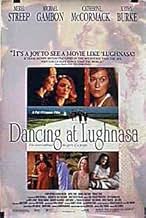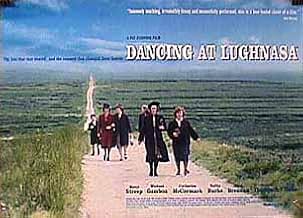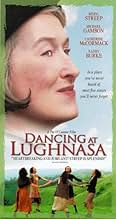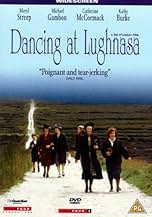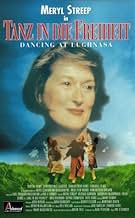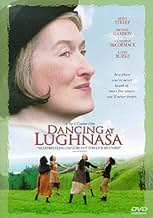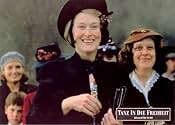PUNTUACIÓN EN IMDb
6,3/10
4,3 mil
TU PUNTUACIÓN
Añade un argumento en tu idiomaFive unmarried sisters make the most of their simple existence in rural Ireland in the 1930s.Five unmarried sisters make the most of their simple existence in rural Ireland in the 1930s.Five unmarried sisters make the most of their simple existence in rural Ireland in the 1930s.
- Dirección
- Guión
- Reparto principal
- Premios
- 2 premios y 7 nominaciones en total
Reseñas destacadas
The acclaimed stage play from Brian Friel has been successfully adapted for the screen in this visual treat from Pat O'Connor. The beautiful landscapes of Donegal do not smother the intelligent performances such as from Meryl Streep (Kate Mundy), Catherine McCormack (Christine Mundy) and Rhys Ifans (Gerry Evans). Those critics who have condemned the movie for being simple and about ordinary people seem to miss the point. This is meant to be a simple story about ordinary people - and that is why it is so moving! More importantly though - 'Dancing at Lughnasa' is also entertaining and really deserved better than the mixed reviews on initial release.
Contemplating suicide? This is just the film for you. It will either put you completely over the top, or convince you that however bad you feel, you might as well live because there are others who are much, much worse off. This is the crushingly sad tale of 5 Irish sisters, each of whom appears to have screwed up any and all chances for personal happiness. Now, stuck together in permanent spinsterhood and extreme poverty, they face economic and personal disaster. Unfortunately, rather than being moved by their plight, I found myself increasingly irritated by their passive reaction to it. Oh yes, if the tragic sisters are not sufficient, there is also the demented, dying brother to cheer things up. Maybe things were really that bad in depression era Ireland. I sincerely hope not. 2 1/2 stars for the scenery and acting.
Watchable but instantly forgettable film of Brian Friel's award-winning play which provides its greatest pleasures through the strong performances of its ensemble cast. Five independent-minded sisters living in Donegal in the mid 1930s face the possibility of change when economic and emotional circumstances conspire against them. The return of their brother from religious missions in Africa signals the beginning, and as the pagan festival of Lughnasa, which celebrates the harvest and forebodes the coming of winter, is celebrated around them, they must come to terms with changes in their own relatively comfortable middle class world. The ten year old son of one of them views events with a nostalgic eye which nonetheless sees the hardship and heartbreak which occurs around him.
Despite director Pat O'Connor's valiant attempts to open out' the play, the film is still extremely theatrical. The inclusion of landscape shots and the restaging of certain scenes in outdoor locations unavailable in the theatre does not really make the film cinematic. It merely adds visuals to what is still a complex series of linguistic exchanges which delineate and explore character. Authentic production design and costuming and the persistent presence of a traditional-themed score by Bill Whelan contribute to the feeling of the film, and with the help of good accent work by the cast, it manages to successfully evoke a feeling of time and place. However it remains an extremely well produced stage play on film, and is still bound by blocking and staging conventions which allow the actors to meet and greet one another to exchange their thoughts and feelings. The closest the film comes to a visual symbolic system is the use of dance and ritual to underscore the social and emotional tensions. The undercurrent of paganism which defines the relationships between people and their sense of the cosmos is constantly evoked (as it was in the play), and the film begins with a credit sequence featuring images of African tribes people in traditional costumes. But other than the climactic dance scene where the sisters celebrate their sisterhood to the strains of ceili music, the film rarely manages to escape the enclosed and cerebral world of the stage version.
But paradoxically, the reliance on actors plying their trade on well written words (rather than visuals) is the thing which saves the film from itself. Meryl Streep gives a convincing performance (and manages a creditable accent) as the repressed, authoritarian schoolteacher who heads the female clan, and she is more than matched by Michael Gambon's endearing performance as the slightly baffled priest whose exposure to the customs and rituals of Africa have coloured his perceptions of home. The rest of the cast (the non-stars, so to speak) are equally good, particularly Sophie Thompson as the simple minded Rose and Kathy Burke as the chain smoking Maggie. Catherine McCormack and Brid Brennan (the latter a veteran of the Abbey Theatre production) have less showy roles, but work distinctive characterisations in with those of the others with ease and skill. Supporting male performances from Rhys Ifans and young Darrell Johnston are also good, and the film also comes with a rich voice over provided by Gerard McSorley (who played the part of the the child at an adult remembering in the stage version).
This aspect of the film alone is probably worth the time and attention required to view it, but on the whole it is a less rewarding experience than the play itself. While an unfair basis upon which to criticise a work of adaptation, the material was perhaps fundamentally unsuited to cinematic treatment. Though Frank McGuinness has done his best to translate the themes and character issues, and has successfully done so insofar as it applies to theme and character, this is not so much a film version as a film of the play with some additional settings and scenes which prevent it from becoming completely unwatchable. What power it has comes from the power of the play, and it is mostly evinced at the level of verbal discourse. Theatrical adaptation is a minefield for film makers and has produced varying results in the past. Dancing at Lughnasa does not distinguish itself in the annals of this sub-section of film history, but for those patient enough with its lack of genuine cinematic interest, it offers certain pleasures which should pass the time painlessly enough.
Despite director Pat O'Connor's valiant attempts to open out' the play, the film is still extremely theatrical. The inclusion of landscape shots and the restaging of certain scenes in outdoor locations unavailable in the theatre does not really make the film cinematic. It merely adds visuals to what is still a complex series of linguistic exchanges which delineate and explore character. Authentic production design and costuming and the persistent presence of a traditional-themed score by Bill Whelan contribute to the feeling of the film, and with the help of good accent work by the cast, it manages to successfully evoke a feeling of time and place. However it remains an extremely well produced stage play on film, and is still bound by blocking and staging conventions which allow the actors to meet and greet one another to exchange their thoughts and feelings. The closest the film comes to a visual symbolic system is the use of dance and ritual to underscore the social and emotional tensions. The undercurrent of paganism which defines the relationships between people and their sense of the cosmos is constantly evoked (as it was in the play), and the film begins with a credit sequence featuring images of African tribes people in traditional costumes. But other than the climactic dance scene where the sisters celebrate their sisterhood to the strains of ceili music, the film rarely manages to escape the enclosed and cerebral world of the stage version.
But paradoxically, the reliance on actors plying their trade on well written words (rather than visuals) is the thing which saves the film from itself. Meryl Streep gives a convincing performance (and manages a creditable accent) as the repressed, authoritarian schoolteacher who heads the female clan, and she is more than matched by Michael Gambon's endearing performance as the slightly baffled priest whose exposure to the customs and rituals of Africa have coloured his perceptions of home. The rest of the cast (the non-stars, so to speak) are equally good, particularly Sophie Thompson as the simple minded Rose and Kathy Burke as the chain smoking Maggie. Catherine McCormack and Brid Brennan (the latter a veteran of the Abbey Theatre production) have less showy roles, but work distinctive characterisations in with those of the others with ease and skill. Supporting male performances from Rhys Ifans and young Darrell Johnston are also good, and the film also comes with a rich voice over provided by Gerard McSorley (who played the part of the the child at an adult remembering in the stage version).
This aspect of the film alone is probably worth the time and attention required to view it, but on the whole it is a less rewarding experience than the play itself. While an unfair basis upon which to criticise a work of adaptation, the material was perhaps fundamentally unsuited to cinematic treatment. Though Frank McGuinness has done his best to translate the themes and character issues, and has successfully done so insofar as it applies to theme and character, this is not so much a film version as a film of the play with some additional settings and scenes which prevent it from becoming completely unwatchable. What power it has comes from the power of the play, and it is mostly evinced at the level of verbal discourse. Theatrical adaptation is a minefield for film makers and has produced varying results in the past. Dancing at Lughnasa does not distinguish itself in the annals of this sub-section of film history, but for those patient enough with its lack of genuine cinematic interest, it offers certain pleasures which should pass the time painlessly enough.
What distinguishes stage from screen? If a viewer had only Brian Friel's play, `Dancing at Lughnasa' and its cinematic adaptation to judge from, he or she might be tempted to answer that, while stage is highly engaging and meaningful, screen is superficial, insulting, and thin in content. Friel's play is structured in such a way that a film version necessarily provides a fascinating comparison of the two mediums. However, director Pat O'Connor's efforts tend to demonstrate the weaknesses of cinema rather than the strengths. Adapting a play to the screen has often proved to be a tricky business; it involves some pitfalls which this film does not manage to avoid.
Screen is extremely literal. It allows for--in fact, often demands-- a sense of realism seldom conveyed on stage. The makers of `Dancing at Lughnasa' are clearly appreciative of this fact, and have made valiant, if not always successful, allowances for it. The primary result of their efforts is a heightened sense of setting. The world these characters inhabit feels real. We get shot after shot of Irish countryside; set and costume design seem perfect for Ireland in the 1930s. Mark Geraghty's production design is one of the best things about this film. Additionally, excellent accent work by all the actors proves perfectly convincing and adds depth to the setting.
However, such a literal medium has its drawbacks. In particular, young Michael's narration, which was used to achieve a specific effect in the play, seems unnecessary here. The play's Michael is full-grown and speaks young Michael's lines as his `memories' take place in the action on stage. The film makers did well to recognize that there was no cinematic equivalent for this; having the adult narrator speak the child's lines would have seemed ridiculous. However, in removing that aspect of the narrator's role, they stripped away most of his significance, as well. The film's narrator seems like an afterthought, occasionally intruding into the action to tell us that what we are seeing is a memory. We could easily forget that the events are, in fact, happening in flashback.
While some of the abstract elements of Friel's original play do not translate well onto the screen, individual performances are only aided by the medium. Since film is not hindered by the simple vocal requirements of stage, the actors are able to convey much more subtlety of meaning. The players in this film version are, without exception, excellent. Meryl Streep stands out as the proper, reserved Kate. Her manner is nervous and slightly shrill, but conveys genuine concern for her sisters. When Kate opens up and allows herself to dance, Streep shows a joyful abandon which is believable and pleasant to see. Another standout performance is delivered by Michael Gambon in the role of Father Jack. His lines are spoken with calm assurance, betraying Jack's senility only by their complete lack of relevance. Gambon's distant eyes and quiet detachment reinforce the feeling that he exists in a world entirely different from the rest of the family, a point which is absolutely crucial to his character. Supporting characters are also portrayed dead-on. This film has some of the best acting that could have been hoped for.
Despite these considerable advantages, the movie runs into trouble when it tries to adapt Friel's plot to the screen. Film is so much more visual than theater that it demands a great deal of variation in order to keep the viewer interested. Since we do not have the benefit of the actors' physical presence, we need other things to hold our attention. In attempting to add variety to the play's structure, screenwriter Frank McGuinness breaks up Friel's original dialogue into smaller scenes, most of which involve household chores. McGuinness also tries to represent some events which the play's dialogue only alludes to. The result is a film which is so fragmented that we lose sight its content. Friel's dialogue is integrally important to his play, and the same is true for the film. However, the way that the film breaks up this dialogue among tiny scenes is extremely distracting. We lose sight not only of the dialogue's meaning, but of the relationships between characters. Since the adapted structure requires that the five sisters rarely appear in the same scene together, it is very difficult to get any sense of the dynamic in the household. Ultimately, so much time is spent with action rather than dialogue that the characters lose a great deal of their depth. Perhaps film makers did not trust their audience to be as interested in the characters as in the events.
It is somewhat unjust to evaluate an adapted play simply in light of the original. However, this cinematic version fails to hold up even on its own terms. It is difficult to conceive what value those who have not been exposed to the original play could see in this adaptation. What we get is a good-looking, but ultimately insubstantial, portrait of five women who could all stand to let their hair down a little bit more than they do. I can't help but think that Friel had more in mind than demonstrating the value of letting one's hair down.
Screen is extremely literal. It allows for--in fact, often demands-- a sense of realism seldom conveyed on stage. The makers of `Dancing at Lughnasa' are clearly appreciative of this fact, and have made valiant, if not always successful, allowances for it. The primary result of their efforts is a heightened sense of setting. The world these characters inhabit feels real. We get shot after shot of Irish countryside; set and costume design seem perfect for Ireland in the 1930s. Mark Geraghty's production design is one of the best things about this film. Additionally, excellent accent work by all the actors proves perfectly convincing and adds depth to the setting.
However, such a literal medium has its drawbacks. In particular, young Michael's narration, which was used to achieve a specific effect in the play, seems unnecessary here. The play's Michael is full-grown and speaks young Michael's lines as his `memories' take place in the action on stage. The film makers did well to recognize that there was no cinematic equivalent for this; having the adult narrator speak the child's lines would have seemed ridiculous. However, in removing that aspect of the narrator's role, they stripped away most of his significance, as well. The film's narrator seems like an afterthought, occasionally intruding into the action to tell us that what we are seeing is a memory. We could easily forget that the events are, in fact, happening in flashback.
While some of the abstract elements of Friel's original play do not translate well onto the screen, individual performances are only aided by the medium. Since film is not hindered by the simple vocal requirements of stage, the actors are able to convey much more subtlety of meaning. The players in this film version are, without exception, excellent. Meryl Streep stands out as the proper, reserved Kate. Her manner is nervous and slightly shrill, but conveys genuine concern for her sisters. When Kate opens up and allows herself to dance, Streep shows a joyful abandon which is believable and pleasant to see. Another standout performance is delivered by Michael Gambon in the role of Father Jack. His lines are spoken with calm assurance, betraying Jack's senility only by their complete lack of relevance. Gambon's distant eyes and quiet detachment reinforce the feeling that he exists in a world entirely different from the rest of the family, a point which is absolutely crucial to his character. Supporting characters are also portrayed dead-on. This film has some of the best acting that could have been hoped for.
Despite these considerable advantages, the movie runs into trouble when it tries to adapt Friel's plot to the screen. Film is so much more visual than theater that it demands a great deal of variation in order to keep the viewer interested. Since we do not have the benefit of the actors' physical presence, we need other things to hold our attention. In attempting to add variety to the play's structure, screenwriter Frank McGuinness breaks up Friel's original dialogue into smaller scenes, most of which involve household chores. McGuinness also tries to represent some events which the play's dialogue only alludes to. The result is a film which is so fragmented that we lose sight its content. Friel's dialogue is integrally important to his play, and the same is true for the film. However, the way that the film breaks up this dialogue among tiny scenes is extremely distracting. We lose sight not only of the dialogue's meaning, but of the relationships between characters. Since the adapted structure requires that the five sisters rarely appear in the same scene together, it is very difficult to get any sense of the dynamic in the household. Ultimately, so much time is spent with action rather than dialogue that the characters lose a great deal of their depth. Perhaps film makers did not trust their audience to be as interested in the characters as in the events.
It is somewhat unjust to evaluate an adapted play simply in light of the original. However, this cinematic version fails to hold up even on its own terms. It is difficult to conceive what value those who have not been exposed to the original play could see in this adaptation. What we get is a good-looking, but ultimately insubstantial, portrait of five women who could all stand to let their hair down a little bit more than they do. I can't help but think that Friel had more in mind than demonstrating the value of letting one's hair down.
Meryl Streep is pretty wonderful. Maybe it's not even her acting at all -- she just has this entranced stare that seems to say so much. But she's not the only one here: almost the entire cast gives fairly excellent performances. The one problem that tore the film apart was Rhys Ifans (the Gerry character). It seemed these two males who intrude on the family are central to the story. The Jack character is funny and moving and works well. The Gerry character does not. His dances in the field with Catherine McCormack make us wonder how much we've missed that we're supposed to absently start liking this guy just because he drives a motorbike and can dance. And with that crucial role unraveled, the film begins to do the same. What we end up with are some moving and notable bits, but that's about all.
¿Sabías que...?
- CuriosidadesOriginal choices to star were Frances McDormand and Kate Winslet.
- PifiasThe radio is one of the first ever made, so it's a tube radio, which would not be able to come on instantly like the later transistor radios; it would have needed a while to warm up before there would be any sound from it.
- Citas
Kate 'Kit' Mundy: I am a righteous bitch, amn't I?
- Créditos adicionalesDuring the opening credits, stills of African tribal dances and of Jack as priest in Africa are shown.
Selecciones populares
Inicia sesión para calificar y añadir a tu lista para recibir recomendaciones personalizadas
Detalles
- Fecha de lanzamiento
- Países de origen
- Sitio oficial
- Idioma
- Títulos en diferentes países
- El ball d'agost
- Localizaciones del rodaje
- Empresas productoras
- Ver más compañías en los créditos en IMDbPro
Taquilla
- Recaudación en Estados Unidos y Canadá
- 2.287.818 US$
- Fin de semana de estreno en EE. UU. y Canadá
- 83.759 US$
- 15 nov 1998
- Recaudación en todo el mundo
- 2.287.818 US$
- Duración1 hora 35 minutos
- Color
- Mezcla de sonido
- Relación de aspecto
- 1.85 : 1
Contribuir a esta página
Sugerir un cambio o añadir el contenido que falta

Principal laguna de datos
By what name was El baile de agosto (1998) officially released in India in English?
Responde

